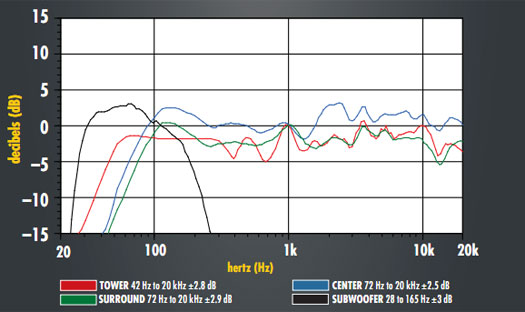Test Report: NHT Absolute 5.1T Speaker System Page 4
BOTTOM LINE
After living with the NHT Absolute Tower for several weeks, I realize it has more in common with an aerobatic plane than with the supersonic bomber I mentioned earlier. It's a precision instrument, not a powerhouse. I consider it an ideal speaker for a budget-minded audiophile, and NHT's full 5.1T system is a good choice for home theaters where subtlety will be valued over strength.
TEST BENCH

Frequency response (at 2 meters)
tower 42 Hz to 20 kHz ±2.8 dB
center 72 Hz to 20 kHz ±2.5 dB
surround 72 Hz to 20 kHz ±2.9 dB
sub 28 to 165 Hz ±3 dB
Sensitivity (SPL at 1 meter with 2.8 volts of pink-noise input)
tower 85 dB
center 84 dB
surround 86 dB
Impedance (minimum/nominal)
tower 4.0/6 ohms
center 7.4/10 ohms
surround 3.9/7 ohms
Bass output, sub (CEA-2010 standard)
Ultra-low bass (20-31.5 Hz): 85.1 dB
Low bass (40-63 Hz): 105.3 dB
Bass limits (lowest frequency and maximum SPL with limit of 10% distortion at 2 meters)
tower 40 Hz at 83 dB
center 50 Hz at 82 dB
surround 50 Hz at 79 dB
sub: 25 Hz at 82 dB SPL
94-dB average SPL from 25 to 63 Hz
103-dB maximum SPL at 63 Hz
bandwidth uniformity 90%
The frequency-response curves shown in the graph are weighted to reflect how sound arrives at a listener's ears with normal speaker placement. Measurements were made at 2 meters to ensure that full effects of cabinet diffraction and front-panel reflections were included. The measurements shown in the graph were taken with the speaker grilles removed. The Absolute Tower was measured standing on the ground, which is the way it will always be used. The Absolute Center and Absolute Zero were measured on a 6-foot stand. These tests gave quasi-anechoic results down to about 250 Hz. Response of woofers was close-miked and spliced to the quasi-anechoic response. The subwoofer's driver and port were close-miked, and their responses summed to produce the curve you see here.
It's obvious from these measurements that someone at NHT knows how to build good speakers and hasn't been restrained from doing so. All of these products deliver textbook responses with no audibly significant flaws. On-axis response is always close to flat, and off-axis response essentially mirrors the on-axis response except for the expected treble rolloff.
The Absolute Tower has a mild dip at 386 Hz caused by the two bottom woofers being out of phase with the midwoofer. It also shows the expected effects of floor bounce, with a dip at 670 Hz and a corresponding peak at 980 Hz. Bass response is considerably underrated: Even in unforgiving distortion tests, the tower showed usable output down to 40 Hz, much better than NHT's 58-Hz rating. Adding the grille causes a dip of -4 dB at 6 kHz, and a few small dips and peaks in the range of ±1 dB.
The Absolute Center delivers excellent results out to 30° off-axis, with only minor frequency-response anomalies. At 45° and 60° off-axis, a dip of about -18 dB shows up at 1.5 kHz. The grille causes some small dips and peaks, typically about ±2 dB.
Above 1 kHz, the Absolute Zero delivered results similar to those of the Absolute Tower, with off-axis response showing a gentle and gradual rolloff above 8 kHz. Adding the grille produces -1.5-dB dips at 6 kHz and 12 kHz.
Sensitivity of all models is a hair on the low side, ranging from 84 to 86 dB. Fortunately, the impedance curves of all three models are pretty reasonable, and the phase curves of the impedance show only mild phase shift, so I'm confident that even a really cheap receiver could drive them to fairly high levels.
We've recently switched to the CEA-2010 method for our subwoofer output measurements. It's quite similar to our previous method, using the same test tones and frequencies, and focusing on distortion instead of the usual low-signal-level amplitude measurements. The main difference is that we'll now be reporting the results in an industry-standard manner. During the transition, we'll cite measurements using both CEA-2010 and our old technique so you can see how they compare.
The Classic Ten's bass output is perhaps a hair better than average for its price and size. By the CEA-2010 standard, average output was 85.1 dB between 20 and 31.5 Hz and 105.3 dB from 40 to 63 Hz. Measured by our old standard, max SPL at 10% THD is 103 dB at 63 Hz, while average SPL is 92 dB and deepest usable bass response is at 25 Hz. These measurements were taken with the internal crossover bypassed. The combined low-pass function of the internal crossover and the driver's natural rolloff is about 24 dB/octave. The boundary-compensation switch on the back begins working at frequencies below 70 Hz, and has its greatest effect at 38 Hz, where it delivers a boost of +3 dB or a cut of -2 dB.-B.B.













































